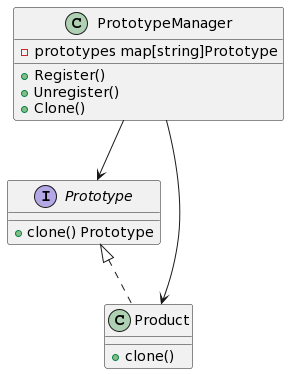1. What is the Prototype Pattern
In software development, the prototype pattern is a creational design pattern that allows creating new objects by copying existing objects without using the new operator. This method makes use of the clone relationship between objects to separate the creation and use of objects.
2. Characteristics and Advantages of the Prototype Pattern
- Characteristics:
- Allows objects to be dynamically created at runtime.
- Reduces the time for object creation and improves system performance.
- Separates the creation and use of objects, making it easy to manage and extend.
- Advantages:
- Improves the efficiency of object creation.
- Simplifies the object creation process.
- Can dynamically increase or decrease objects.
3. Application Scenarios of the Prototype Pattern in Golang
The prototype pattern is suitable for the following scenarios:
- When the creation of objects is complex, but it is more efficient to create objects by copying existing objects.
- When there is a need to dynamically create or clone objects, rather than directly creating new object instances.
4. Implementation of the Prototype Pattern in Golang
4.1. UML Class Diagram

4.2. Implementation Step 1: Create a Prototype Interface
First, create a prototype interface that defines the clone method.
type Prototype interface {
clone() Prototype
}
4.3. Implementation Step 2: Create and Clone Objects Using the Prototype Interface
4.3.1. Create a Prototype Manager Class
The prototype manager class is responsible for creating and managing prototype objects.
type PrototypeManager struct {
prototypes map[string]Prototype
}
func NewPrototypeManager() *PrototypeManager {
return &PrototypeManager{
prototypes: make(map[string]Prototype),
}
}
func (pm *PrototypeManager) Register(name string, prototype Prototype) {
pm.prototypes[name] = prototype
}
func (pm *PrototypeManager) Unregister(name string) {
delete(pm.prototypes, name)
}
func (pm *PrototypeManager) Clone(name string) Prototype {
prototype, ok := pm.prototypes[name]
if ok {
return prototype.clone()
}
return nil
}
4.3.2. Create and Clone Objects Using the Prototype Manager Class
type Product struct {
name string
}
func (p *Product) clone() Prototype {
return &Product{
name: p.name,
}
}
func main() {
manager := NewPrototypeManager()
// Register prototype objects in the prototype manager class
manager.Register("productA", &Product{name: "Product A"})
// Create and clone objects using the prototype manager class
productA := manager.Clone("productA").(*Product)
fmt.Println(productA.name) // Output: Product A
}
4.4. Implementation Step 3: Considerations and Best Practices for Using the Prototype Pattern
When using the prototype pattern, the following points should be noted:
- The prototype pattern is suitable for use when the cost of object creation is high, as cloning objects can save creation time.
- Pay attention to the implementation of the object’s clone method to ensure that the cloned object is consistent with the original.